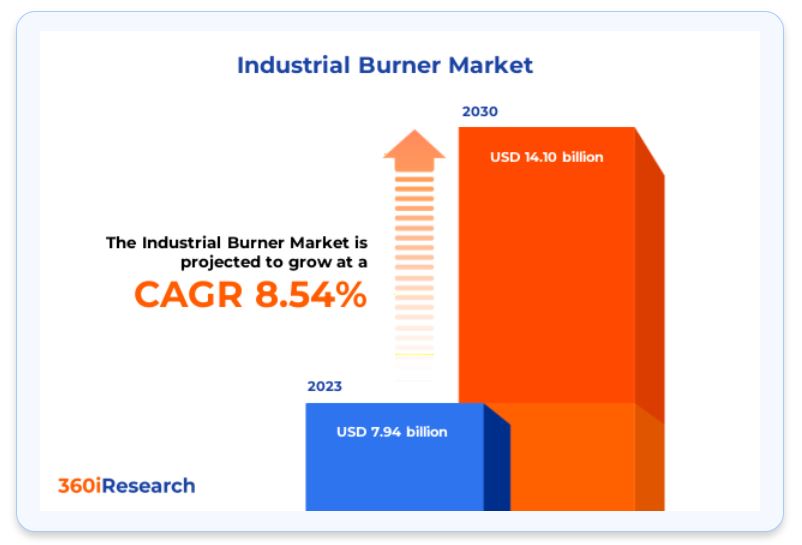| 【英語タイトル】Industrial Burner Market - Global Forecast 2025-2030
|
 | ・商品コード:360i23DC386
・発行会社(調査会社):360iResearch
・発行日:2024年12月
・ページ数:約110
・レポート言語:英語
・レポート形式:PDF
・納品方法:Eメール(受注後2-3営業日)
・調査対象地域:グローバル
・産業分野:装置・機械
|
◆販売価格オプション
(消費税別)
※販売価格オプションの説明
※お支払金額:換算金額(日本円)+消費税
※納期:即日〜2営業日(3日以上かかる場合は別途表記又はご連絡)
※お支払方法:納品日+5日以内に請求書を発行・送付(請求書発行日より2ヶ月以内に銀行振込、振込先:三菱UFJ銀行/H&Iグローバルリサーチ株式会社、支払期限と方法は調整可能)
|
❖ レポートの概要 ❖
The Industrial Burner Market size was estimated at USD 7.94 billion in 2023 and expected to reach USD 8.58 billion in 2024, at a CAGR 8.54% to reach USD 14.10 billion by 2030.
The scope of the industrial burner market encompasses equipment utilized for heating or burning fuels to produce heat in various industrial processes such as chemical production, food processing, and manufacturing. These burners are crucial in industries where precise temperature control and energy efficiency are paramount. The necessity of industrial burners arises from their critical role in achieving high operational efficiency, reducing energy consumption, and minimizing emissions in alignment with environmental regulations. Applications range from steam generation to material heating and incineration, with end-use markets including petrochemicals, power generation, and food and beverage sectors. Key factors influencing growth include a heightened focus on reducing greenhouse gas emissions, advancements in burner technologies that improve fuel efficiency, and the rising demand for energy-intensive industries. Opportunities emerge from the escalating adoption of clean energy sources and the integration of smart technologies to enhance burner performance and monitoring. Companies can leverage these trends by investing in research and development of advanced combustion systems, such as low NOx burners and hybrid burners that utilize renewable fuels.
However, the market is not without challenges. Stringent environmental regulations can increase operational costs, requiring substantial investment in cleaner technologies. Moreover, fluctuating fuel prices and the inherent complexities of integrating advanced systems can hinder adoption rates. The industrial burner market also faces limitations with respect to market saturation in developed regions and the dependency on capital-intensive industries. To address these challenges, innovation areas such as the development of adaptive control systems, modular designs for scalability, and enhanced heat recovery solutions offer potential for growth. Additionally, partnerships with technology firms could foster advancements in machine learning algorithms for process optimization and predictive maintenance. Overall, understanding regional regulatory landscapes and cultivating a robust innovation pipeline will be crucial for businesses seeking to capitalize on growth prospects in a competitive market landscape.
Market Segmentation & Coverage
This research report categorizes the Industrial Burner Market to forecast the revenues and analyze trends in each of the following sub-markets:
• Fuel Type
o Biofuel Burners
Biodiesel
Ethanol
o Dual Fuel Burners
Gas and Oil
o Gas Burners
LPG
Natural Gas
o Oil Burners
Heavy Oil
Light Oil
• Application
o Power Generation
Nuclear Power
Thermal Power
• End-User Industry
o Chemical & Petrochemical
Petrochemical Processing
o Oil & Gas
Downstream
Refineries
Upstream
• Technology Type
o Low-NOx Burners
Ultra-Low NOx Burners
• Burner Design
o Monoblock Type
Compact Design
• Region
o Americas
Argentina
Brazil
Canada
Mexico
United States
California
Florida
Illinois
New York
Ohio
Pennsylvania
Texas
o Asia-Pacific
Australia
China
India
Indonesia
Japan
Malaysia
Philippines
Singapore
South Korea
Taiwan
Thailand
Vietnam
o Europe, Middle East & Africa
Denmark
Egypt
Finland
France
Germany
Israel
Italy
Netherlands
Nigeria
Norway
Poland
Qatar
Russia
Saudi Arabia
South Africa
Spain
Sweden
Switzerland
Turkey
United Arab Emirates
United Kingdom





